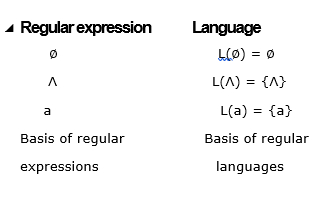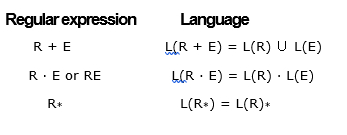
 Data Structure
Data Structure Networking
Networking RDBMS
RDBMS Operating System
Operating System Java
Java MS Excel
MS Excel iOS
iOS HTML
HTML CSS
CSS Android
Android Python
Python C Programming
C Programming C++
C++ C#
C# MongoDB
MongoDB MySQL
MySQL Javascript
Javascript PHP
PHPPhysics
Chemistry
Biology
Mathematics
English
Economics
Psychology
Social Studies
Fashion Studies
Legal Studies
- Selected Reading
- UPSC IAS Exams Notes
- Developer's Best Practices
- Questions and Answers
- Effective Resume Writing
- HR Interview Questions
- Computer Glossary
- Who is Who
Explain about regular expressions in TOC?
A regular expression is basically a shorthand way of showing how a regular language is built from the base set of regular languages.
The symbols are identical which are used to construct the languages, and any given expression that has a language closely associated with it.
For each regular expression E, there is a regular language L(E).
Example 1
If the regular expression is as follows −
a + b · a*
It can be written in fully parenthesized form as follows −
(a + (b · (a*)))
Regular expressions vs. Languages
The symbols of the regular expressions are distinct from those of the languages. These symbols are given below −

Operators in Regular expression −
There are two binary operations on regular expressions (+ and ·) and one unary operator (*)

These are closely associated with the union, product and closure operations on the corresponding languages.
Example 1
The regular expression a + bc* is basically shorthand for the regular language {a} ∪ ({b} · ({c}*)).
Example 2
Find the language of the given regular expression. It is explained below −
a + bc*.
L(a + bc*) = L(a) ∪ L(bc*)
= L(a) ∪ (L(b) · L(c*))
= L(a) ∪ (L(b) · L(c)*)
= {a} ∪ ({b} · {c}*)
= {a} ∪ ({b} · {∧, c, c2, . . . , cn, . . . , })
= {a} ∪ {b, bc, bc2, . . . , bcn, . . . }
= {a, b, bc, bc2, . . . , bcn, . . . }.

